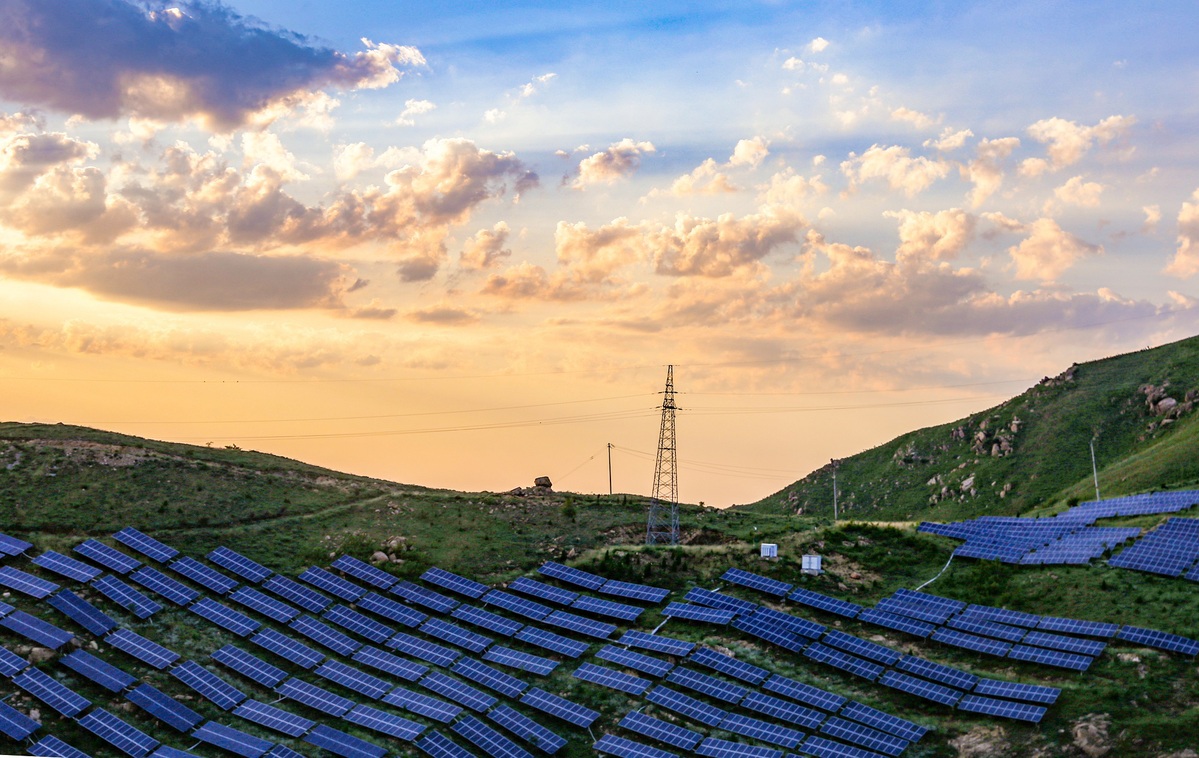
Rows of photovoltaic panels installed over the hills provide unique scenery in Nianzhang town of Xiaxian county in Yuncheng city, Shanxi province. [Photo by Zhang Xiufeng/For chinadaily.com.cn]
As China ramps up generation of clean power, its need for a new type of power system is on the rise, as the nation aims to address challenges brought on by unstable renewable energy, driving advancements in manufacturing and emerging sectors such as smart grids, experts said.
By the end of June, China's installed renewable energy capacity had reached 1.65 billion kilowatts, a 25 percent increase from the previous year. It makes up about 53.8 percent of the nation's total power generation capacity.
The combined capacity of wind and solar power (1.18 billion kW) has exceeded that of coal power (1.17 billion kW), said the National Energy Administration. According to the China Renewable Energy Engineering Institute, installed capacity of new energy power generation will continue to increase and reach around 1.6 billion kW by 2025.
Looking ahead, there are obstacles to the sector's development, as the intermittency of renewable energy sources poses challenges for the traditional power system. There is an urgent need to enhance the grid's capacity to better integrate green power, said experts.
To this end, China released an action plan recently to step up the construction of a new type of power system in the 2024-27 period, focusing on fields such as high-quality development of grid's distribution networks and expansion of electric vehicle charging infrastructure.
Experts said that driven by policy, upgrades and transformations across multiple system components — power generation plants, grid, consumption and storage facilities — will present various opportunities for relevant businesses. Emerging sectors such as new energy storage, virtual power plants and smart grids are expected to benefit more.
"By 2060, it is estimated that clean energy power generation will make up 90 percent of total power generated in China. Clean power will become a major part of energy consumption," said Shu Yinbiao, an academician of the Chinese Academy of Engineering, during an event in Beijing on Wednesday.
"In this context, the power system will change significantly. On the generation side, sources will shift from strongly controllable coals to weakly controllable and highly unstable new energies. On the grid side, the focus will move from large grids to a mix of large grids, distribution systems and microgrids."
Hydropower, Shu said, can provide essential support for the safe operation of the new type of power system, playing a crucial role in maintaining voltage stability.
Pumped storage hydropower is also important for the new type of power system as it secures constant renewable energy supply to power systems by storing excess energy and discharging it when needed. Its energy conversion efficiency can reach about 70 to 80 percent and costs only around 40 percent of those for electrochemical storage, the academician said.
In addition to pumped storage, new types of energy storage technologies such as compressed-air energy storage with flexible layouts and short construction periods are also advancing rapidly.
NEA data showed that by mid-2024, the installed capacity of operational new types of energy storage projects nationwide reached 44.44 million kW, an increase of over 40 percent from the end of 2023.
The new type of power system's development is also speeding up advancements in large grid and grid's distribution networks, with power scheduling and grid operations increasingly integrating technologies like artificial intelligence. This not only benefits related manufacturing industries but also fosters new business models such as AI-driven grid inspections, smart grids, and virtual power plants, said Lin Boqiang, head of the China Institute for Studies in Energy Policy at Xiamen University.
Lin said coal power may still remain a cornerstone to secure basic energy supply in the short term, driving the development of new technologies such as carbon capture, utilization and storage through the fossil fuels' low-carbon and clean utilization.
Source: By Liu Yukun, chinadailly.com, Aug 22, 2024 [https://www.chinadaily.com.cn/a/202408/22/WS66c69294a31060630b924577.html]

